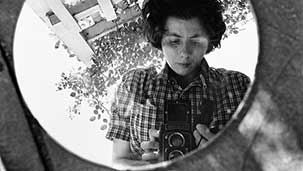No one was as close to Vivian Maier as you were. Literally. In every picture we see of Vivian, there you are, slung around her neck or cradled in her hands. The two of you were inseparable. Through you, Vivian was able to communicate her sense of empathy, wit, and macabre humour. Without you, it seems she had a much more difficult time interacting with the world around her. And by all accounts she was perfectly okay with that.
In 2007, filmmaker John Maloof was looking for black and whites for an unrelated project, and bid on a box of old photographs at an auction. In that box, he discovered the work of an unknown street photographer. In Finding Vivian Maier, Maloof attempts to unravel the mystery of the eccentric nanny who took hundreds of thousands of extraordinary photographs of strangers, yet left behind very few clues about her own life.
Maloof (who also wrote, directed, and produced this documentary) knew that he had stumbled upon a gold mine. What you and Vivian were able to achieve together was nothing short of staggering—both in quality and quantity. Her ability to capture the mundane goings-on of American city life in the mid-20th Century is remarkable for its depth of emotion and level of skill. Particularly for someone who, as we find out, had no formal training. She was able to achieve these fascinating candid portraits thanks to you. Your compact design, with the viewfinder on top, meant that Vivian’s subjects often didn’t know she was taking their picture. It allowed her to engage with the subject without being obvious and gave her photographs an almost perverse sense of immediacy.
It’s unfortunate, then, that Finding Vivian Maier fails to grab the audience with the same level of nuance or whimsy.
What we learn about Vivian is revealed through interviews with the families she worked for as a nanny. She is described as mysterious, paradoxical, and, above all, discrete. Though everyone remembers you as being Vivian’s most constant companion (her charges do recall being marched through some of Chicago’s seedier neighbourhoods) no one remembers ever having seen her photographs, and Maloof never bothers to ask. This is a startling exclusion, and at odds with the narrative Maloof seems intent on advancing. Instead he shows us the trunks and suitcases full of film and photos and other cameras that he liberated from her storage unit, lays them out Tetris-like on his floor, and talks about the moral dilemma of exploiting a dead artist, as though daring us to question his aw-shucks sincerity.
The closest we get to finding Vivian is through her photographs. Maloof shows some to preeminent photographer Mary Ellen Mark, who compares Vivian’s work to such renowned artists as Diane Arbus, Robert Frank, and Lisette Model. It’s only in these scenes, and the precious few moments when Vivian’s photographs linger onscreen for longer than a second, that provide the most insight into her offbeat behaviour. We are invited to imagine what kind of life the two of you could have led if only Vivian had sought notoriety. The people who knew her best – which they all admit was not very well – unanimously agree that she would have hated this invasion of her privacy, and the very notion of being found.
We’re supposed to believe that the mystery of Vivian is more interesting than the work itself. But it’s not. When Maloof is not despairing of dealing with the sheer volume of Vivian’s work and getting it the attention it deserves, he is busy forcing intrigue where there is very little to be found. Yes, Vivian was a nanny, who lived austerely and eccentrically, wearing men’s shirts and affecting a muddled European accent, but beyond that she was no weirder than any other prolific artist. The more riveting story is the one Maloof doesn’t tell, about the controversy surrounding his “discovery” of Vivian, and his refusal to acknowledge that he is not the sole owner of her work. It’s hard not to view Finding Vivian Maier as a glorified infomercial for The Maloof Collection.
Like most co-dependent relationships, yours and Vivian’s wasn’t the healthiest. As she aged, she became increasingly unstable, and eventually left you for a younger model. But in its heyday, your partnership yielded a literal hoard of snapshots of America in its prime. From painted ladies in convertibles to indigent men on strip club stoops, you allowed Vivian to keep a measure of distance between herself and the world, which, in turn, allowed us a deeper insight into its soul. And hers.
The only thing Finding Vivian Maier makes perfectly clear is that Vivian was never lost when she had you.
Candidly yours,
Di







